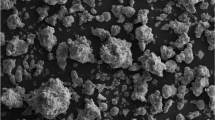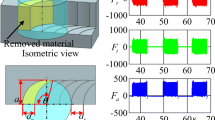Abstract
The generation mechanism of machining-induced residual stresses is a complex nonlinear and thermal–mechanical coupling problem. The cutting forces and cutting temperature produced in machining process must be considered simultaneously. The influence of cutter orientation and feed per tooth on the cutting speed, cutting forces, cutting temperature, and residual stresses is discussed in the present study. Effective cutting speed in accordance with the inclination angle in feed direction is analyzed. The cutting forces are gained by milling experiment, and the cutting temperature is obtained by finite element method. Moreover, the influence of the effective cutting speed on the cutting forces and cutting temperature is stated, and the relationship among the cutting forces, cutting temperature, and residual stresses is discussed. The experimental and numerical methods are both adopted in this study to give a better understanding of the milling process. After analysis of the phenomenon, several conclusions are made. The inclination angle in feed direction affects the effective cutting speed, and then the cutting forces, cutting temperature, and residual stresses are affected. Priority selection of inclination angle in feed direction is suggested from 5° to 30° in order to reduce the cutting forces. The overall trend of the workpiece temperature presents the parabolic shape, while the chip temperature increases with the increasing inclination angle in feed direction. Residual stress in feed direction almost increases with the increasing feed per tooth, which is not obvious in the general scope of the feed rate. The inclination angle of 5° and 15° is the priority in order to produce residual compressive stresses in cross feed direction.
Similar content being viewed by others
References
Chen JY, Conlon K, Xue L, Rogge R (2010) Experimental study of residual stresses in laser clad AISI P20 tool steel on pre-hardened wrought P20 substrate. Mater Sci Eng A 527(27–28):7265–7273
She C-H, Chang C-C (2008) Development of internet-based system for multi-axis surface manufacturing. Int J Adv Manuf Technol 40(9–10):982–992
Lu Y, Takeuchi Y, Takahashi I, Anzai M (2005) An integrated system development for ball end mill design, creation and evaluation. Int J Adv Manuf Technol 25(7–8):628–646
Routara BC, Bandyopadhyay A, Sahoo P (2008) Roughness modeling and optimization in CNC end milling using response surface method: effect of workpiece material variation. Int J Adv Manuf Technol 40(11–12):1166–1180
Ozcelik B, Oktem H, Kurtaran H (2005) Optimum surface roughness in end milling Inconel 718 by coupling neural network model and genetic algorithm. Int J Adv Manuf Technol 27(3):234–241
Ding T, Zhang S, Wang Y, Zhu X (2010) Empirical models and optimal cutting parameters for cutting forces and surface roughness in hard milling of AISI H13 steel. Int J Adv Manuf Technol 51(1–4):45–55
Quintana G, Garcia-Romeu ML, Ciurana J (2009) Surface roughness monitoring application based on artificial neural networks for ball-end milling operations. J Intell Manuf 22(4):607–617
Brecher C, Quintana G, Rudolf T, Ciurana J (2010) Use of NC kernel data for surface roughness monitoring in milling operations. Int J Adv Manuf Technol 53(9–12):953–962
Outeiro JC, Pina JC, Msaoubi RM, Pusavec F, Jawahir IS (2008) Analysis of residual stresses induced by dry turning of difficult-to-machine materials. CIRP Ann Manuf Technol 57(1):77–80
Denkena B, Boehnke D, León L (2008) Machining induced residual stress in structural aluminum parts. Prod Eng 2(3):247–253
James M, Hughes D, Chen Z, Lombard H, Hattingh D, Asquith D, Yates J, Webster P (2007) Residual stresses and fatigue performance. Eng Fail Anal 14(2):384–395
Wiesner C (1992) Residual stresses after orthogonal machining of AlSl 304: numerical calculation of the thermal component and comparison with experimental results. Met Mater Trans A 23(3):989–996
Jacobus Kurt, Kapoor SG, DeVor RE (2001) Experimentation on the residual stresses generated by end milling. J Manuf Sci Eng 123(4, 748):748–753
Nasr M, Ng EG, Elbestawi M (2007) Effects of workpiece thermal properties on machining-induced residual stresses—thermal softening and conductivity. Proc IME B J Eng Manuf 221(9):1387–1400
Nasr M, Ng EG, Elbestawi M (2007) Modelling the effects of tool-edge radius on residual stresses when orthogonal cutting AISI 316L. Int J Mach Tools Manuf 47(2):401–411
Schulze V, Autenrieth H, Deuchert M, Weule H (2010) Investigation of surface near residual stress states after micro-cutting by finite element simulation. CIRP Ann Manuf Technol 59(1):117–120
Shet C, Deng X (2003) Residual stresses and strains in orthogonal metal cutting. Int J Mach Tools Manuf 43(6):573–587
Daymi A, Boujelbene M, Ben Amara A, Bayraktar E, Katundi D (2011) Surface integrity in high speed end milling of titanium alloy Ti-6Al-4V. Mater Sci Technol 27(1):387–394
Su JC (2006) Residual stress modeling in machining processes. PhD Thesis, Georgia Institute of Technology
Shatla M, Kerk C, Altan T (2001) Process modeling in machining. Part I: determination of flow stress data. Int J Mach Tool Manuf 41(10):1511–1534
Author information
Authors and Affiliations
Corresponding author
Rights and permissions
About this article
Cite this article
Chen, X., Zhao, J., Li, Y. et al. Investigation on ball end milling of P20 die steel with cutter orientation. Int J Adv Manuf Technol 59, 885–898 (2012). https://doi.org/10.1007/s00170-011-3565-2
Received:
Accepted:
Published:
Issue Date:
DOI: https://doi.org/10.1007/s00170-011-3565-2




